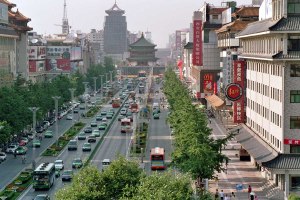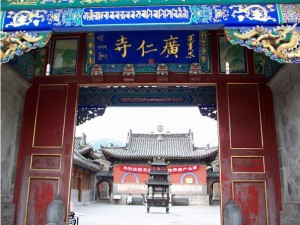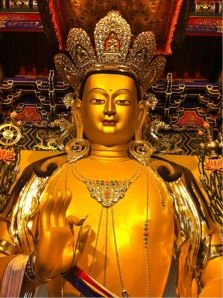 “I lost most of my Xian photos after returning my blackberry to my previous employer; all photos here were found from Google….”
“I lost most of my Xian photos after returning my blackberry to my previous employer; all photos here were found from Google….”
Summer 2012, my first stop to China and Tibetan Amdo region was Xian; the ancient capital of Han and Tang dynasty but it is only a second tier metropolitan in today’s People Republic of China. “Western” influence flourished before the Muslim dominated Middle East and gradually the silk road trade, which eventually forces European to discovery of the New World but that’s not what we are going to discuss here. “Western” influence as the ancient Chinese knew it mainly referred to India, Persia, Arabia, and Roman Empire. The silk road trade brought different exotic spices like cumming popular in Northwestern Chinese cuisine; mystical creature (to the ancient Chinese spectators) such as Lions, Peacock, and elephants; foreign furniture such as chairs, which was not integrated into the Chinese culture until Song dynasty; and philosophical ideas from Buddhism, Christianity, and Islam have also reached China via silk road. I cannot be fully certain but I understood that main influences of Chinese Buddhism came from Greco-Buddhist nations along the silk road rather than directly from India.
My purpose to Xian was strictly business, therefore I did not visit the Terracotta Army nor any other popular tourist spots. However I did manage to escape from my unsuccessful business venture and visited Geuangren Lamasery (China refers to Tibetan Buddhist monastery as Lamasery) ; a Gelugpa Buddhist monastery largely unheard of even by the locals.
 The monastery was built several hundreds years ago in Qing Dynasty by the imperial family that followed the Buddhist Gelugpa tradition. It served the purpose of being a monastery for Manchurian/Mongolian elites and also as a resting place for the Dalai Lama, Panchen Lama, or other high lama on their way to Beijing. Today the monastery is still actively promoting Buddhism and charity works in Xian. Out of admiration for the beautiful monastery and their works, I offered a portion of my traveling budget to the monastery for reconstructing one of their halls dedicated to one-thousands Lama Tsongkhapa statues.
The monastery was built several hundreds years ago in Qing Dynasty by the imperial family that followed the Buddhist Gelugpa tradition. It served the purpose of being a monastery for Manchurian/Mongolian elites and also as a resting place for the Dalai Lama, Panchen Lama, or other high lama on their way to Beijing. Today the monastery is still actively promoting Buddhism and charity works in Xian. Out of admiration for the beautiful monastery and their works, I offered a portion of my traveling budget to the monastery for reconstructing one of their halls dedicated to one-thousands Lama Tsongkhapa statues.
Similar to Yonghegong Lamasery (if I remember correctly) Gelugpa monasteries in China would have at least three main halls the first venerates Shakyamuni Buddha who appeared in his supreme emanated form to show living beings the dharma; the second hall venerates Lama Tsongkhapa who found the Gelug tradition; and the third hall is dedicated to Maitreya the next Buddha who will appear aeons after Buddhism disappear from our time. However Guangrensi is special that their first main hall venerates Green Tara instead of Shakyamuni Buddha. According to my lovely tour guide (a lay student of their venerable abbot) there is a beautiful history behind this.
In Tang Dynasty Xian, there was a time when Tibetan kings would marry Chinese princesses. As one of her dowry the Princess took the Xian’s Shakyamuni statue to Tibet.
One night, the Chinese emperor was looking at the empty throne of Shakyamuni Buddha and thought “Who will protect Buddhism in China now that the Buddha is in Tibet…?”
That very moment the very same Green Tara statue in Guangrensi replied “Don’t worry I will protect and spread Buddhism in China.” As a result of this conversation between Green Tara and the emperor, Guangrensi installed Green Tara as their main deity when it was being constructed. The tour guide also stated to me in great pride that although themonastery is not well known their Green Tara statue is famous all the way to Tibet and Mongolia. (The picture below is their 9m tall Maitreya; for I failed to locate a picture of Guangrensi Green Tara)
This concludes my trip to Xian. After that I left for Amdo, Tibet (Today being incorporated into the Chinese province Qinghai) with my younger brothers. Next post, I will write about an interesting conversation I had with a Taoist lady during my visit to Guangrensi, which involve discussion on Buddhist refuge and renunciation.


Your street image from the South Gate creates the illusion of proximity: with the aid of a fairly clear day, I can see Zhong Lo and the North Gate in one shot. Nicely done.
wow….. you know your photography. All credit goes to the person who took the picture. I used others’ pictures of Xian because I lost mine…… 😦
I misinterpreted your “found on Google” comment to mean your Google account.
Not fun losing images you spent time and effort to take.
Here’s my attempt at a similar effect but over a much larger distance.
http://zhouxingyu.wordpress.com/2012/03/14/crow-compression/
Nice little story here. Thanks for sharing it.